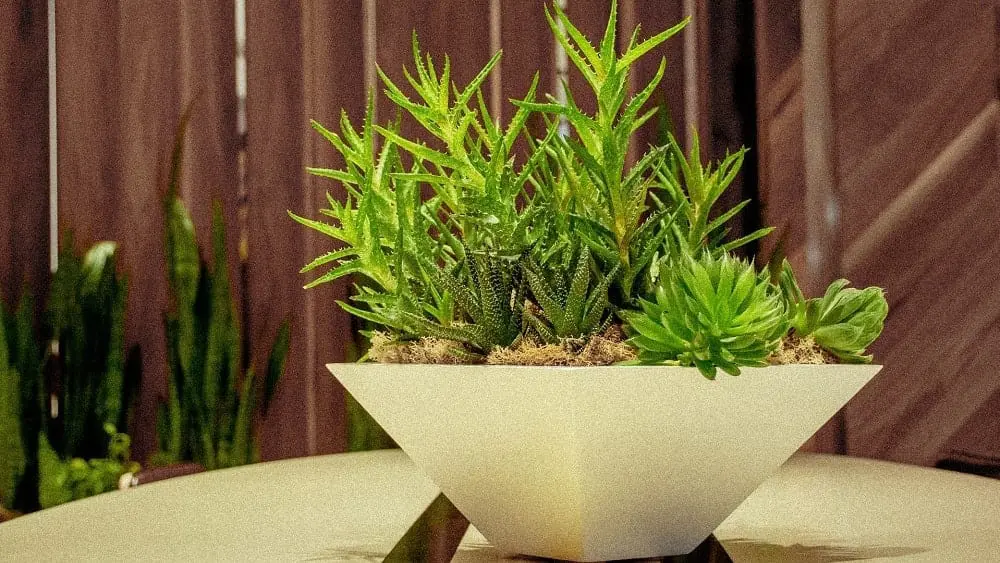
If you were around in the 1970s and 1980s, the idea of artificial plants may scare you. After all, fabric petals and garish colors were the norm back then. No wonder the trend went dormant for a while before finally coming back with a splash in recent years.
Today, interior designers swear by artificial plants. In fact, in many cases, they prefer them, especially for hard-to-reach areas like shelves that could use a pop of green. Not only do artificial plants require minimal maintenance, saving you money in the long run, they also never outgrow their pots, droop, or lose their coloring — and they’re safe and non-toxic, a major plus if you have pets or allergies; it’s a win-win many times over. The best part? The industry has advanced significantly in recent years and many of today’s artificial plants look as good as — or in some cases, better than — the real thing.
Whenever possible, buy artificial plants in person, especially if you’re a first-timer. If that’s not possible, read reviews and buy from reputable brands such as Grandin Road, Terrain, World Market, and West Elm. If it’s florals and holiday greenery in particular you’re after, Balsam Hill is a designer favorite.
If you’re not sure where to start, choose something like aloe, birds of paradise, succulents, or spider plants. Artificial versions of these plants are some of the most real-looking available. If you’re a fan of the fiddle leaf fig trend, Apartment Therapy tested a slew of artificial varieties and determined that World Market’s takes the prize for most authentic.
Here are a few more tips to ensure your faux greenery looks realistic.
- Skip unnatural colors. Make sure the colors of your artificial plant closely resemble what you would find in nature. There should be color and textural variations, but nothing so wildly different that it appears odd or fake. It’s a fine line, but it’s easier to tell than it sounds. Just take a few seconds to scan the plant and you’ll instantly get a feel for how authentic the colors and texture look and feel.
- Look for imperfections. No living plant is 100 percent the same throughout. Leaves have veining variations. Stems and buds have color disparities. If an artificial plant looks perfect, it probably doesn’t look very real. A plant’s true beauty lies in the slightly imperfect nooks and crannies, so look for those whenever you can.
- Add natural touches. One way to make artificial plants look even more real is to add natural elements, such as a few rocks, pebbles, or sheet or sphagnum moss. These not only cover up root areas that may appear fake, they’re organic nature tricks the eye into thinking you’re seeing the real thing.
- Minimize the shine. Glossy leaves and petals were a major trend in the 1970s, but not so much anymore. Extras like fake raindrops only make an artificial plant look more artificial, so avoid those and be on the lookout for leaves that appear bright but not glassy.
- Planter perfection. Never underestimate the power of a container to make its contents look stunning. An artificial plant tucked into an old or ugly pot isn’t doing your decor any favors, but slip it into an elegant planter that fits with the decor of your home and suddenly you’re the plant lady.
- Keep the dust off. While artificial plants don’t require the same upkeep as natural plants, they still benefit from some maintenance. Keeping them free of dust and debris will help them retain their natural look – in stature and color.
- Make the seasonal switch. Nobody’s orchid blooms all year. Whatever plant you choose, consider any seasonal display changes that may require you to move it out of sight for a bit or risk being called out. Also, whether it’s indoors or out, select a spot that would make sense for the natural version of plant you choose. If it’s a low-light room, a plant that thrives in direct sunlight might instantly seem fake but an artificial “low-light” angel plant may be right at home.
- Mix artificial and natural plants. No home should be filled with only artificial plants. There are plenty of hard-to-kill houseplants that are easy to grow and when mixed in with artificial plants, it creates a more natural, overall look. Mixing them is also more cost-effective, plus you’re guaranteed a home with some green no matter the season. Finally, try placing your artificial plant where they can’t be examined up close. Shelves and cabinets are perfect for artificial houseplants because they add a pop of green to a room without the likelihood that anyone will notice they are merely imitations of the real thing.

Ana Connery is former content director of Parenting, Babytalk, Pregnancy Planner and Conceive magazines as well as parenting.com.
While editor in chief of Florida Travel & Life magazine from 2006-2009, she covered the state’s real estate and home design market as well as travel destinations.
She’s held senior editorial positions at some of the country’s most celebrated magazines, including Latina, Fitness and Cooking Light, where she oversaw the brand’s “FitHouse” show home.
Ana’s expertise is frequently sought after for appearances on “The Today Show,” “Good Morning America” and CNN. She has interviewed the country’s top experts in a variety of fields, including U.S. Secretary of Education Arne Duncan and First Lady Michelle Obama.
 Christmas Decorating Based On Your Décor Style
Christmas Decorating Based On Your Décor Style